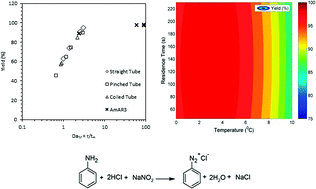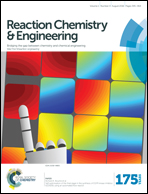Selectivity engineering of the diazotization reaction in a continuous flow reactor†
Abstract
In situ generated diazonium salts are useful intermediates for the synthesis of fine chemicals and active pharmaceutical ingredients. This paper presents a methodology for selectivity engineering of the diazotization reaction in a continuous reactor. The yield of diazotization was found to depend on mixing, dispersion, reaction kinetics, operating temperature and residence time. Initially, experimental data and an isothermal axial dispersion model were used for estimating mixing time. A correlation for estimating mixing time for different flow reactors is proposed. The model predictions were compared with the experimental data. The validated axial dispersion model and Central Composite Design (CCD) were used to optimize diazotization in a straight tube reactor (1.78 mL). The model was then used for scaling-up of aniline diazotization from a straight tube reactor to a proprietary AmAR3 reactor (scale-up ratio of ∼20). The initial concentration, inlet temperature, average heat capacity of the reaction mixture, mixing, residence time (distribution) and available heat transfer area per unit volume of the reactor were found to be the key parameters for scaling-up of the diazotization reaction. The presented approach and results will be useful to practicing chemists and engineers for enhancing the selectivity of diazotization reactions in continuous reactors.


 Please wait while we load your content...
Please wait while we load your content...